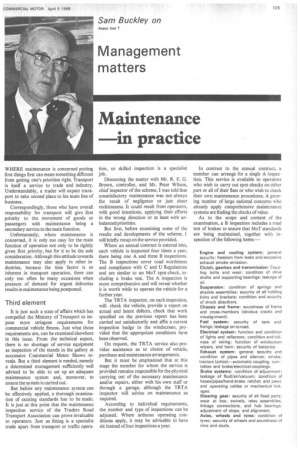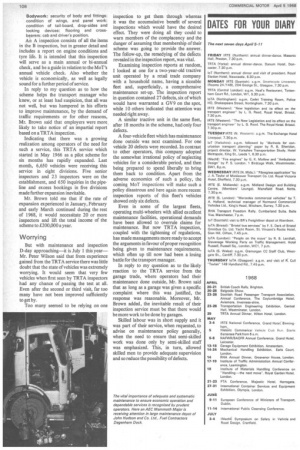Management matters
Page 107

Page 108

If you've noticed an error in this article please click here to report it so we can fix it.
Maintenance in practice
WHERE maintenance is concerned putting first things first can mean something different from getting one's priorities right. Transport is itself a service to trade and industry. Understandably, a trader will expect transport to take second place to his main line of business.
Correspondingly, those who have overall responsibility for transport will give first priority to the movement of goods or passengers with maintenance being a secondary service to the main function.
Unfortunately, where maintenance is concerned, it is only too easy for the main function of operation not only to be rightly given first priority, but for it to be the sole consideration. Although this attitude towards maintenance may also apply in other industries, because the time factor is so inherent in transport operation, there can only too often be many occasions when pressure of demand for urgent deliveries results in maintenance being postponed.
Third element
It is just such a state of affairs which has compelled the Ministry of Transport to impose more stringent requirements for commercial vehicle fitness. Just what those requirements are, can be examined elsewhere in this issue. From the technical aspect, there is no shortage of service equipment as inspection of the stands in the gallery at successive Commercial Motor Shows reveals. But a third element is needed, namely a determined management sufficiently well advised to be able to set up an adequate maintenance system and, moreover, to ensure the system is carried out.
But before any maintenance system can be effectively applied, a thorough examination of existing standards has to be made. It is just at this point that the maintenance inspection service of the Traders Road Transport Association can prove invaluable to operators. Just as fitting is a specialist trade apart from transport or traffic opera
tion, so skilled inspection is a specialist job.
Discussing the matter with Mr. R. E. G. Brown, controller, and Mr. Peter Wilson, chief inspector of the scheme, I was told that unsatisfactory maintenance was not always the result of negligence or just sheer recklessness. It could result from operators, with good intentions, applying their efforts in the wrong direction or at least with unbalanced priorities.
But first, before examining some of the results and developments of the scheme, I will briefly recap on the service provided.
Where an annual contract is entered into, each vehicle is inspected four times a year, there being one A and three B inspections. The B inspections cover road worthiness and compliance with C and U Regulations and are similar to an MoT spot-check, including a brake test. The A inspection is more comprehensive and will reveal whether it is worth while to operate the vehicle for a further year.
The TRTA inspector, on each inspection, will: check the vehicle, provide a report on actual and latent defects, check that work specified on the previous report has been carried out satisfactorily and affix a current inspection badge to the windscreen, provided that the appropriate conditions have been observed.
On request, the TRTA service also provides assistance as to choice of vehicle, purchase and maintenance arrangements.
But it must be emphasized that at this stage the member for whom the service is provided remains responsible for the physical carrying out of the necessary maintenance and/or repairs, either with his own staff or through a garage, although the TRTA inspector will advise on maintenance as required.
According to individual requirements, the number and type of inspections can be adjusted. Where arduous operating conditions apply, it may be advisable to have six instead of four inspections a year. In contrast to the annual contract, a member can arrange for a single A inspection. This service is available to operators who wish to carry out spot-checks on either part or all of their fleet or who wish to check their own maintenance procedures. A growing number of large national concerns who already apply comprehensive maintenance systems are finding the checks of value.
As to the scope and content of the examination, a B inspection includes a road test of brakes to ensure that MoT standards are being maintained, together with inspection of the following items: Engine and cooling system: general security; freedom from leaks and excessive exhaust smoke emission.
Clutch, gearbox and transmission: Coupling bolts and wear: condition of drive shafts and supporting bearings; leakage of oil.
Suspension: condition of springs and shackle assemblies: security of all holding bolts and brackets: condition and security of shock absorbers.
Chassis and frame: soundness of frame and cross-members (obvious cracks and misalignment).
Fuel system: security of tank and fixings; leakage on to road.
Electrical system: function and condition of lights and reflectors; condition and tidiness of wiring; function of windscreen wipers, and horn; security of batteries. Exhaust system: general security and condition of pipes and silencer, smoke; tractors (artics)—automatic coupling, turntables and brake/electrical couplings. Brake systems: condition of adjustment; leakage of fluid/air/vacuum: condition of hoses/pipes/hand-brake ratchet and pawl, and .operating cables or mechanical linkages.
Steering gear: security of all fixed parts: wear at box, swivels, relay assemblies, linkage connections, and hub bearings: adjustment of stops, and alignment. Axles, wheels and tyres: condition of tyres; security of wheels and soundness of rims and studs.
Bodywork: security of body and fittings; condition of wings, and panel work; condition of tail-board, drop-sides and locking devices; flooring and crossbearers; cab and driver's position.
An A inspection consists of all the items in the B inspection, but in greater detail and includes a report on engine conditions and tyre life. It is intended that this inspection will serve as a main annual or bi-annual check, and be a guide in relation to the MoT's annual vehicle check. Also whether the vehicle is economically, as well as legally sound for a further period of service.
In reply to my question as to how the scheme helps the transport manager who knew, or at least had suspicion, that all was not well, but was hampered in his efforts to improve maintenance, by the demand of traffic requirements or for other reasons, Mr. Brown said that employers were more , likely to take notice of an impartial report based on a TRTA inspection.
Indicating that there was a growing realization among operators of the need for such a service, this TRTA service which started in May 1966 as a pilot scheme for six months has rapidly expanded. Last month, 6,650 vehicles were receiving this service in eight divisions. Five senior inspectors and 23 inspectors were on the establishment, and 650 inquiries in the pipeline and excess bookings in five divisions made further expansion inevitable.
Mr. Brown told me that if the rate of expansion experienced in January, February and early March continued during the rest of 1968, it would necessitate 20 or more inspectors and lift the total income of the scheme to £200,000 a year.
Worrying
But with maintenance and inspection D-day approaching—it is July 1 this year— Mr. Peter Wilson said that from experience gained from the TRTA service there was little doubt that the state of vehicles was extremely worrying. It would seem that very few vehicles when first seen by TRTA inspectors had any chance of passing the test at all. Even after the second or third visit, far too many have not been improved sufficiently to get by.
Too many seemed to be relying on one inspection to get them through whereas it was the accumulative benefit of several inspections which would have the desired effect. They were doing all they could to warn members of the complacency and the danger of assuming that membership of their scheme was going to provide the answer. The follow-up, the remedying of the defects revealed in the inspection report, was vital.
Examining inspection reports at random, I looked at one for a two-year-old tractive unit operated by a retail trade company with a household name, having a sizeable fleet and, superficially, a comprehensive maintenance set-up. The inspection report in question contained 27 defects, six of which would have warranted a GV9 on the spot, while 10 others indicated that attention was needed right away.
A similar tractive unit in the same fleet, after 18 months in the scheme, had only four defects.
A four-vehicle fleet which has maintenance done outside was next examined. For one vehicle 20 defects were recorded. In contrast to other operators, this company adopted the somewhat irrational policy of neglecting vehicles for a considerable period, and then being prepared to spend liberally to bring them back to condition. Apart from the adverse economics of such a policy, the coming MoT inspections will make such a policy disastrous and here again more recent inspection reports of this fleet's vehicles showed only six defects.
Even in some of the largest fleets, operating multi-wheelers with allied excellent maintenance facilities, operational demands have been allowed to overrule claims for maintenance. But now TRTA inspection, coupled with the tightening of regulations, has made managements more ready to accept the arguments in favour of proper recognition being given to maintenance requirements, which often up till now had been a losing battle for the transport manager.
In reply to my question as to the likely reaction to the TRTA service from the garage trade, where operators had their maintenance done outside, Mr. Brown said that as long as a garage was given a specific complaint where this was justified, the response was reasonable. Moreover, Mr. Brown added, the inevitable result of their inspection service must be that there would be more work to be done by garages.
Skilled labour was in short supply and it was part of their service, when requested, to advise on maintenance policy generally, when the need to ensure that semi-skilled work was done only by semi-skilled staff was emphasized. This, in turn, allowed skilled men to provide adequate supervision and so reduce the possibility of defects.




























































































































































